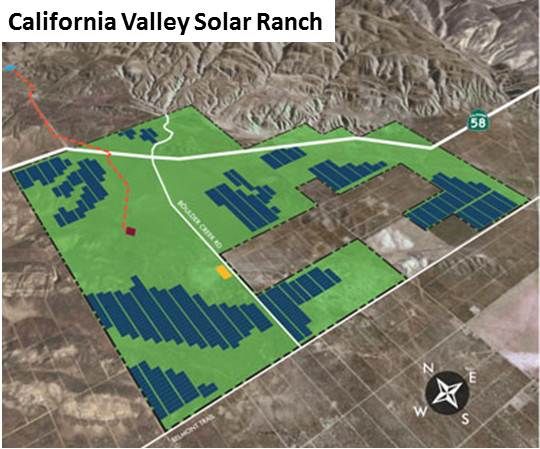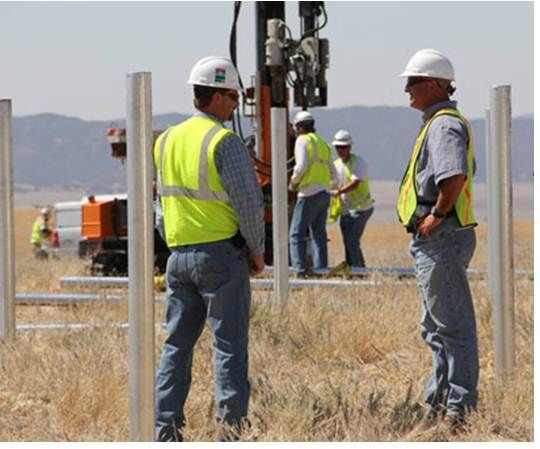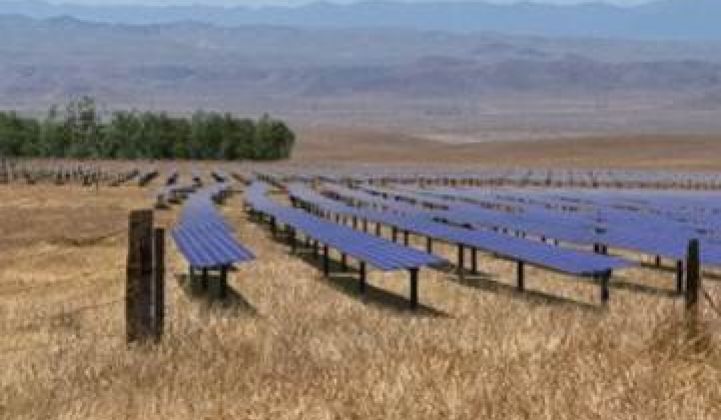NRG Energy’s Randy Hickok built combined-cycle thermal plants until, after well over a decade of fossil plant construction, he decided the solar industry was the real deal.
As NRG Energy’s Vice President of Asset Management, Hickok is overseeing the construction of California Valley Solar Ranch (CVSR). The 250-megawatt project, which will be one of the world’s biggest photovoltaic (PV) solar power plants, formally broke ground November 10.
“SunPower lived with the project through the development and permitting stage,” Hickok said of the solar panel manufacturer from which NRG Energy purchased CVSR. SunPower also secured the vital 25-year power purchase agreement with Pacific Gas & Electric.
In addition, SunPower laid the groundwork for a relationship with the surrounding community and ultimately reached a crucial settlement with environmental groups North County Watch and Carrizo Commons to protect the Carrizo Plain where the project is being built.
The settlement limits the life of the project to 50 years; commits the project owner to a decommissioning process that restores the site; provides for enhanced protective collaboration during construction; and commits funding to research on endangered species and to development of a long-term vision for the Carrizo Plain.
The settlement was built on prior design commitments that resulted, Hickok said, in a project that is two-thirds green space with ten separate, strategically sited areas for panels.

SunPower will supply crystalline silicon PV panels as part of its Oasis Power Plant product, a modular solar power block comprised of panels, SunPower’s wirelessly controlled T0 Tracker, pre-manufactured cabling, and a state-of-the-art smart inverter and operating system. The module arrives at the construction site in pre-assembled kits.
With trackers, Hickok noted, the system produces “25 percent more power,” so “less land is required.”
CVSR will ultimately provide 350 construction jobs, with 80 already filled, and approximately 15 permanent operations and maintenance positions. Hickok said the initial work on the project’s 25-megawatt Phase One is on track for spring 2012 completion. The 75-megawatt Phase Two should be finished late next year, and the final 75-megawatt phase is scheduled to be ready in 2013.
Having initiated the project’s design and construction, SunPower will complete that work in conjunction with Bechtel, which NRG Energy chose for engineering, procurement and construction (EPC) services.
Two factors determined the choice of Bechtel. There is “regulatory compliance,” Hickok noted. “Because of the DOE loan guarantees, these projects have federal reporting requirements, and you know Bechtel will show up with systems and people familiar with government contracts.” There is also “quality control,” he said. “Bechtel will adhere to laws governing the project and make sure we are getting the plant we intended to get.”
Hickok and NRG Energy will be involved throughout construction, because during the construction process, a new set of issues typically arise between the developer and the community. “We wouldn’t be comfortable turning over the key,” Hickok said.
Hickok oversees a construction management group that remains “close to construction details and can rectify what needs rectifying.” They are currently working to resolve complaints about construction vehicles from the nearby city of Santa Margarita. The builders, Hickok said, are considering changing to an approach where they source some construction materials so as to reroute the vehicles.
As a former resident of San Luis Obispo County, where CVSR is being built, Hickok said a developer needs to make it clear from the beginning how residents can address grievances. If a community cannot get satisfaction through the developer, “I would take it to the County and ask who’s in charge,” he said. “The company should be cooperating with the County, keeping the elected officials in the loop and staying aware of who can change things if there are difficulties.”

California’s citizen watchdogs are notorious. “There are always going to be people keeping close tabs on the construction and making sure you are staying in compliance with the terms of the permit,” he said. “But we should be doing that. You want to see the project done in a timely way and on budget -- and neither can happen if you have community resistance.”
As issues arise at CVSR, according to County Supervisor James Patterson, “The county and the construction company are moving quickly to address them."
The costs of mitigating construction issues, Hickok said, “are something you take into consideration during siting -- and if you don’t do your homework, you risk failure.” He added, “If you don’t take on the cost to do it right,” he added, “it could cost more.”
The point, he said, is that “any local resident impacted wants to be made whole.”
On the other hand, projects do get abandoned if the costs of mitigation “bury the economics of the project.”
Stakeholders need to understand, Hickok explained, that “a developer’s resources are not a bottomless well and there’s a limit before the project is not viable.”
Hickok said he would still be building thermal plants if he didn’t believe solar is the right thing. “I’d like to build CVSR in a manner that it is best-in-class” and results in “a warm glow about solar power.”
But he also intends to do the right thing the right way. “I got into this side of the business to be enthused about making solar more viable and I don’t want to shoot solar in the foot.”



